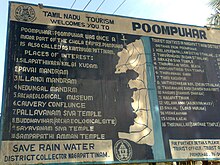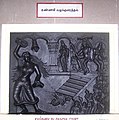| This page is currently being merged. After a discussion, consensus to merge this page with Poombuhar was found. You can help implement the merge by following the instructions at Help:Merging and the resolution on the discussion. Process started in November 2022. |
Town in Tamil Nadu, India
| Puhar | |
|---|---|
| Town | |
   | |
| Coordinates: 11°08′38″N 79°51′18″E / 11.144°N 79.855°E / 11.144; 79.855 | |
| Country | |
| State | Tamil Nadu |
| District | Mayiladuthurai |
| Elevation | 1 m (3 ft) |
| Language | |
| • Official | Tamil |
| • Additional official | English |
| Time zone | UTC+5:30 (IST) |
| Telephone code | 04364 |
| Vehicle registration | TN-82-Z |
| Nearest city | Mayiladuthurai, Sirkazhi |
| Lok Sabha constituency | Mayiladuthurai |
Puhar (also known as Poompuhar) is a town in the Mayiladuthurai district in the southern Indian state of Tamil Nadu. It was once a flourishing ancient port city known as Kaveri Poompattinam, which is described in Post Sangam literature like Silappadikaram, Manimekalai, Paṭṭiṉappālai (Sangam Literature) and Akananuru (Sangam Literature) as the capital of the Early Chola kings in Tamilakam. Puhar is located near the mouth of the Kaveri river, on the sea coast. It is mentioned in the Periplus of the Erythraean Sea.
Marine archaeological research (conducted by the National institute of marine archaeology, Goa) indicates that much of the town was washed away by progressive erosion and floods. In the 1960s and 1970s, archaeological research was conducted under the archaeologist K. V. Soundararajan. Submerged wharves and several meter lengths of pier walls excavated in recent times have corroborated the literary references to Poompuhar. It was rebuilt several times after that. Pottery dating back to the 4th century BCE has been discovered off shore by marine archaeologists east of the town.
City layout
| Chola kings and emperors | ||||||||||||||||||||||||||||||||
|---|---|---|---|---|---|---|---|---|---|---|---|---|---|---|---|---|---|---|---|---|---|---|---|---|---|---|---|---|---|---|---|---|
Early Cholas
|
||||||||||||||||||||||||||||||||
| Interregnum (c. 200 – c. 848 CE) | ||||||||||||||||||||||||||||||||
Medieval Cholas
|
||||||||||||||||||||||||||||||||
Later Cholas
|
||||||||||||||||||||||||||||||||
| Related | ||||||||||||||||||||||||||||||||
Related dynasties
|
||||||||||||||||||||||||||||||||
| Chola society | ||||||||||||||||||||||||||||||||
The general plan of the city of Puhar is described in considerable detail in the fifth book of Silapathikaram. The town was built on the north banks of the river Kaveri. The town had two distinct districts, Maruvurpakkam near the sea and Pattinappakkam to its west. These two villages were separated by a stretch of gardens and orchards where daily markets were held under the shades of the trees. The market place was known as Naalangadi during the day and as allangadi by night.


Maruvurpakkam
The district of Maruvurpakkam was near the beach and had several terraced mansions and warehoused with windows shaped like the eyes of the deer. Maruvurpakkam being close to the shore and hence to the shipyard was naturally preferred by the many overseas travellers, merchants and yavanas (Greeks).
Maruvurpakkam was inhabited by the fisher folk. The town had several warehouses. Weavers, silk merchants, vendors, fish and meat sellers, potters, grain merchants, jewellers and diamond makers lived in Maruvurppakkam.
Pattinappakkam
The King and nobles, rich traders, physicians, astrologers, members of the king's army and court dancers occupied Pattinappakkam. The five Manrams - Vellidai Manram, Elanchi Manram, Nedankal manram, Poothachathukkam and Pavaimanram were located in Pattinappakkam. Gardens like Elavanthikaicholai, Uyyanam, Chanpathivanam, Uvavanam, and Kaveravanam added beauty to the town.
In culture
The city of Poompuhar is a very ancient one.
Descriptions in Tamil poetic works
A Purananuru poem (poem 30) says that big ships entered the port of Puhar without slacking sail, and poured out onto the beach precious merchandise brought from overseas. In the extensive markets of Puhar there were many tall mansions surrounded by platforms reached by high ladders. These mansions had many apartments and were provided with doorways, great and small, and with wide hallways and corridors (Pattinappaalai – II –142-158). In all parts of the town there were flags flying of various kinds and shapes.
Pattinappaalai, a poem that describes the ancient Puhar very vividly, was written by the poet Kadiyalur Uruthirangannanaar is part of the Ten Idylls anthology and was sung in praise of Karikala Chola, a second-century CE Chola king.
In Buddhist literature
Buddhadatta, the 5th century writer who lived during the reign of Accutavikkante vividly describes the capital Kaveripattinam in his manuals (Pali language) as follows:
In the lovely Kaveripattana crowded with hordes of men and women from pure families endowed with all the requisites of a town with crystal clear water flowing in the river, filled with all kinds of precious stones, possessed of many kinds of bazaars, beautified by many gardens, in a beautiful and pleasant vihara built by Kanhadasa, adorned with a mansion as high as the Kailasa, and having different kinds of beautiful entrance-towers on the outer wall, I lived in an old mansion there and wrote this work..
In the Nigamanagātha of Vinayavinicchaya, Buddhatta describes how he wrote the work while staying at the monastery built by one Venhudassa (Vishnudasa) on the banks of the Kaveri in a town called Bhootamangalam near Kaveripattinam.
Merchants of Puhar
Pattinappaalai also gives an idealised description of the merchants plying their trade in Puhar (Pattinappaalai – II – 199–212):
- They shunned murder, and put aside theft, pleased the gods by fire offerings,…they regarded others rights as scrupulously as their own, they took nothing more than was due to them and never gave less than was due from them. Trading thus in many articles of merchandise, they enjoyed an ancient heritage of prosperity and lived in close proximity to one another.
City's destruction
The ancient city of Puhar was destroyed by the sea around 300 AD. Marine archaeologists from the National Institute of Oceanography have established that this could have been the effects of sediment erosion and periodic tsunamis. Such a tsunami is mentioned in the Tamil poem Manimekhalai (see below), which relates that the town Kāveripattinam or Puhār was swallowed up by the sea. This event is supported by archaeological finds of submerged ruins off the coast of modern Poompuhar. The town of Kāveripattinam is believed to have disappeared around 300 AD due to this tsunami
Manimekalai
The ancient Tamil poem Manimekalai by the poet Seethalai Saathanar is set in the town of Kaveripattanam. Ancient ruins of a 4th-5th-century Buddhist monastery, a Buddha statue, and a Buddhapada (footprint of the Buddha) were found in another section of the ancient city, now at Pallavanesvaram. Also some claim that Manimekalai attained Mukti there.
Geography
Kaveripattanam is located at 11°08′21″N 79°50′57″E / 11.13917°N 79.84917°E / 11.13917; 79.84917. It has an average elevation of 1 m (3.3 ft).
It is at a distance of 24km from Mayiladuthurai and 40km Chidambaram.
Politics
Poompuhar assembly constituency is part of Mayiladuturai (Lok Sabha constituency).
Tourism

Attractions in Poompuhar include:
- Silappathikara Art Gallery: scenes from Silappadikaram are depicted in sculptures carved by the students of the Mamallapuram Art College.
- Masilamani Nathar Koil, Tarangambadi: built in 1305 by Maravarma Kulasekara Pandiyan, this temple has been heavily eroded by the sea.
Gallery
-
 Fishermen's vessels
Fishermen's vessels
-
 Ilango Adigal (poet prince)
Ilango Adigal (poet prince)
-
 Kannagi In Pandya Court
Kannagi In Pandya Court
-
 Sculpture of Kovalan and Kannagi at the art gallery entrance
Sculpture of Kovalan and Kannagi at the art gallery entrance
Notes
- ^ "52nd Report of the Commissioner for Linguistic Minorities in India" (PDF). nclm.nic.in. Ministry of Minority Affairs. Archived from the original (PDF) on 25 May 2017. Retrieved 21 July 2019.
- ":::TTDC - Places".
- Ajay Mitra Shastri, R. K. Sharma, Devendra Handa (2005). Revealing India's Past Recent Trends in Art and Archaeology : Prof. Ajay Mitra Shastri Commemoration Volume · Volume 1. Aryan Books International. p. 33.
{{cite book}}: CS1 maint: multiple names: authors list (link) - The March of India, Vol 8. Publications Division, Ministry of Information and Broadcasting, 1956. p. 52.
- Mu Aruṇācalam. The Kalabhras in the Pandiya Country and Their Impact on the Life and Letters There. University of Madras, 1979. p. 53.
- Gaur A. S. and Sundaresh, Underwater Exploration off Poompuhar and possible causes of its Submergence, 1998, Puratattva, 28: 84-90. Available online at
- Marine archaeological explorations of Tranquebar-Poompuhar region on Tamil Nadu coast, Rao, S.R.. Journal of Marine Archaeology, Vol. II, July 1991, pp. 5–20. Available online at Archived 24 January 2011 at the Wayback Machine
- "Indian town sees evidence of ancient tsunami", Associated Press report, Poompuhar,14 January 2005. Available online at
- Rao Bahadur Krishnaswāmi Aiyangar, Maṇimekhalai in its Historical Setting, London, 1928. Available at www.archive.org
- Hisselle Dhammaratana,Buddhism in South India, Buddhist Publication Society, Kandy, 1964. Available on Buddhist Publication Society Online Library Archived 4 March 2016 at the Wayback Machine
- Marine archaeological explorations of Tranquebar-Poompuhar region on Tamil Nadu coast., Rao, S.R.. Journal of Marine Archaeology, Vol. II, July 1991, pp. 6. Available online at Archived 24 January 2011 at the Wayback Machine
- "Maps, Weather, and Airports for Kaveripattanam, India". www.fallingrain.com.
- "List of Parliamentary and Assembly Constituencies" (PDF). Tamil Nadu. Election Commission of India. Archived from the original (PDF) on 4 May 2006. Retrieved 12 October 2008.
- ":::TTDC - Places".
References
- Mudaliar, A.S, Abithana Chintamani (1931), Reprinted 1984 Asian Educational Services, New Delhi.
- Nilakanta Sastri, K.A. (1935). The CōĻas, University of Madras, Madras (Reprinted 1984).
- Wayback Machine
External links
| Mayiladuthurai district | |
|---|---|
| District headquarters | |
| Country | |
| State | |
| Region | |
| Divisions | |
| Taluks | |
| Revenue blocks | |
| Municipalities | |
| Rivers | |
| History | |
| Places of interest | |
| Kaveri basin | |
|---|---|
| Riparian states/UT | |
| Tributaries | |
| Distributaries | |
| Dams | |
| Waterfalls and lagoons | |
| Geographical features | |
| Bridges | |
| Cities and towns |
|
| Islands | |
| Related | |
| Silappatikaram by Ilango Adigal | |
|---|---|
| Characters | |
| Place | |